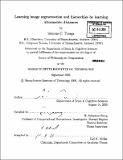| dc.contributor.advisor | H. Sebastian Seung. | en_US |
| dc.contributor.author | Turaga, Srinivas C | en_US |
| dc.contributor.other | Massachusetts Institute of Technology. Dept. of Brain and Cognitive Sciences. | en_US |
| dc.date.accessioned | 2010-04-28T17:11:33Z | |
| dc.date.available | 2010-04-28T17:11:33Z | |
| dc.date.copyright | 2009 | en_US |
| dc.date.issued | 2009 | en_US |
| dc.identifier.uri | http://hdl.handle.net/1721.1/54626 | |
| dc.description | Thesis (Ph. D.)--Massachusetts Institute of Technology, Dept. of Brain and Cognitive Sciences, 2009. | en_US |
| dc.description | Cataloged from PDF version of thesis. | en_US |
| dc.description | Includes bibliographical references (p. 100-105). | en_US |
| dc.description.abstract | In this thesis I present new contributions to the fields of neuroscience and computer science. The neuroscientific contribution is a new technique for automatically reconstructing complete neural networks from densely stained 3d electron micrographs of brain tissue. The computer science contribution is a new machine learning method for image segmentation and the development of a new theory for supervised hierarchy learning based on ultrametric distance functions. It is well-known that the connectivity of neural networks in the brain can have a dramatic influence on their computational function . However, our understanding of the complete connectivity of neural circuits has been quite impoverished due to our inability to image all the connections between all the neurons in biological network. Connectomics is an emerging field in neuroscience that aims to revolutionize our understanding of the function of neural circuits by imaging and reconstructing entire neural circuits. In this thesis, I present an automated method for reconstructing neural circuitry from 3d electron micrographs of brain tissue. The cortical column, a basic unit of cortical microcircuitry, will produce a single 3d electron micrograph measuring many 100s terabytes once imaged and contain neurites from well over 100,000 different neurons. It is estimated that tracing the neurites in such a volume by hand would take several thousand human years. Automated circuit tracing methods are thus crucial to the success of connectomics. In computer vision, the circuit reconstruction problem of tracing neurites is known as image segmentation. Segmentation is a grouping problem where image pixels belonging to the same neurite are clustered together. While many algorithms for image segmentation exist, few have parameters that can be optimized using groundtruth data to extract maximum performance on a specialized dataset. In this thesis, I present the first machine learning method to directly minimize an image segmentation error. It is based the theory of ultrametric distances and hierarchical clustering. Image segmentation is posed as the problem of learning and classifying ultrametric distances between image pixels. Ultrametric distances on point set have the special property that | en_US |
| dc.description.abstract | (cont.) they correspond exactly to hierarchical clustering of the set. This special property implies hierarchical clustering can be learned by directly learning ultrametric distances. In this thesis, I develop convolutional networks as a machine learning architecture for image processing. I use this powerful pattern recognition architecture with many tens of thousands of free parameters for predicting affinity graphs and detecting object boundaries in images. When trained using ultrametric learning, the convolutional network based algorithm yields an extremely efficient linear-time segmentation algorithm. In this thesis, I develop methods for assessing the quality of image segmentations produced by manual human efforts or by automated computer algorithms. These methods are crucial for comparing the performance of different segmentation methods and is used through out the thesis to demonstrate the quality of the reconstructions generated by the methods in this thesis. | en_US |
| dc.description.statementofresponsibility | by Srinivas C. Turaga. | en_US |
| dc.format.extent | 105 p. | en_US |
| dc.language.iso | eng | en_US |
| dc.publisher | Massachusetts Institute of Technology | en_US |
| dc.rights | M.I.T. theses are protected by
copyright. They may be viewed from this source for any purpose, but
reproduction or distribution in any format is prohibited without written
permission. See provided URL for inquiries about permission. | en_US |
| dc.rights.uri | http://dspace.mit.edu/handle/1721.1/7582 | en_US |
| dc.subject | Brain and Cognitive Sciences. | en_US |
| dc.title | Learning image segmentation and hierarchies by learning ultrametric distances | en_US |
| dc.type | Thesis | en_US |
| dc.description.degree | Ph.D. | en_US |
| dc.contributor.department | Massachusetts Institute of Technology. Department of Brain and Cognitive Sciences | |
| dc.identifier.oclc | 601858876 | en_US |
